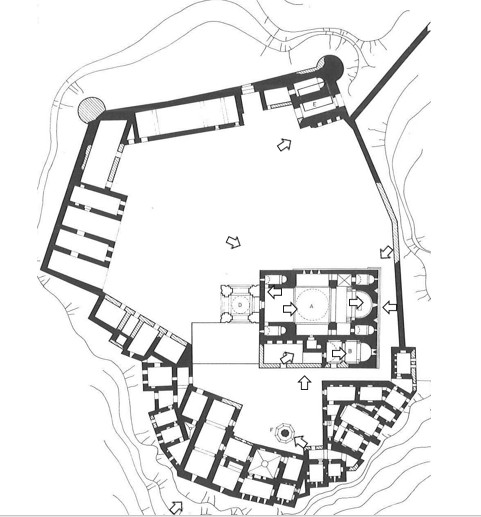Polina Ivanova
Tatev lies in the southernmost part of Armenia, the province of Syunik bordering Nakhichevan and Nagorno-Karabakh to the west and east, and Iran to the south. The seat of the bishop from the ninth century onwards, Tatev was an administrative and intellectual centre of the province of Siunik, which was an independent kingdom between the years 987 and 1170. The initial construction of the monastery should probably be seen in the light of the formation of an independent Armenian princedom after over a century of Arab domination. The twelfth century brought much destruction to the monastery: first the earthquake of 1138 and then the Seljuk attack of 1170. It was restored in the thirteenth century by the Orbelian family, and much of what we know about the monastery comes from the History of Syunik by Stephanos Orbelian, who served as the bishop of Syunik at the time when the restored monastery flourished (late C13). The monastery enjoyed tax exemption under the Mongols and seems to have benefited from Pax Mongolica and the trade that passed through the region. It was again destroyed by Timur in 1380 and, like many other monasteries, restored in the C17-18. As it was located at the border of the Persian and the Russian empires, it suffered further through the late C18 and early C19 and was finally seriously damaged during the earthquake of 1931 when the dome of the church of Sts Paul and Peter and the bell tower were destroyed.
Presently the monastery consists of three churches (Sts Peter and Paul, St Gregory the Illuminator, St Astvatatsin – mother of God), a bell tower, a mausoleum and a number of buildings that have been identified as a refectory, library, administrative buildings etc.
The principal church, the church of Sts Paul and Peter was constructed by the bishop Hovhannes with the support of the princes of Syunik., according to the inscription in 895-906 on the khachkar of Hovhannes in the western wall. The dome and the drum were destroyed in 1138 and reconstructed in C13 (1253/1274), then again destroyed in 1931. The structure of this building is unique comprising a combination of a seventh-century inscribed cross resting on columns and a tenth-century dome resting on piers. On the east side the dome rests on two columns while on the west side it is supported by the angles of two small rooms. One can interpret the two columns as Peter and Paul, whose relics are supposedly buried underneath them. The interior decoration of the church is quite plain, a plausible explanation of which is that already in the tenth century the church was decorated with frescos. The frescoes include Christ enthroned in the conch, prophets and apostles in two registers below, the apostles around the Virgin and St John the Baptist. The north wall depicted the Nativity, and the Last Judgement occupied the west wall.
Interactive Plan

Image Gallery
Bibliography
- Ōrbelyan, Stepʻanos., and Brosset, Marie-Félicité, trans. Histoire De La Siounie. Saint-Pétersbourg: Académie Impériale Des Sciences, 1864.
- La Porta, Sergion. “Grigor Tat‘évatsi et l’École monastique de Tatʾev.” In Illuminations d’Arménie. Arts du livre et de la pierre dans l’Arménie ancienne et médiévale, ed. By V. Calzolari. Cologny, 2007, 210-14.
- Manukyan, Seyranush. “Freski Tateva,” Հոդվածների ժողովածու նվիրված Ֆելիքս Տեր–Մարտիրոսովի հիշատակին (2015): 296-325 [in Russian].
- Rapti, Ioanna. “Le Jugement dernier arménien : réception et évolution d’une imagerie eschatologique médiévale.” Cahiers archéologiques n°56 (2016).
- Thierry, Jean Michel. Répertoire Des Monastères Arméniens. Corpus Christianorum. Turnhout: Brepols, 1993.


